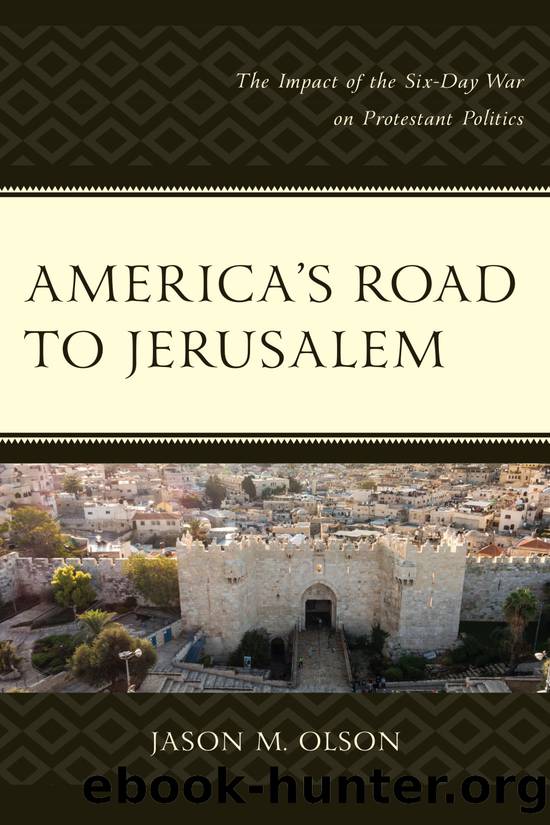America's Road to Jerusalem by Olson Jason M.;

Author:Olson, Jason M.;
Language: eng
Format: epub
Publisher: Lexington Books/Fortress Academic
Chapter 4
American Protestantism and Israel in the Aftermath of the Six-Day War
(1968â1973)
Introduction
For Evangelicals, the Six-Day War vindicated their approach to the Bible. In the dispensationalist scheme, the latter-day Jewish State was to have Jerusalem as its capital and the Temple Mount secure for the future construction of Ezekielâs millennial temple. This John Nelson Darby prediction, first popularized in the 1830s in the British Isles and the United States, appeared to have been fulfilled in history by the State of Israel in 1967. Dispensationalism, which was so popular among Evangelicals and fundamentalists, was also disparaged by Modernists, especially after 1925. But the Six-Day War appeared to prove dispensationalism and its biblical literalism correct, putting Evangelicals back at the forefront of American Protestantism. The rise of Billy Graham as âAmericaâs Pastorâ demonstrated this shift. His relationship with the State of Israel and the Jewish people was a core part of the burgeoning legitimacy and authority of Evangelical dispensationalism.
The fundamentalists were mostly positive about Zionism before the Six-Day War (except for the anti-Semitic elements of that branch), seeing it as fulfillment of prophecy; but after the war they became more preoccupied with the rebuilding of the Jerusalem Temple. The fundamentalists began to sync with the pro-Temple Israeli ultra-Orthodox position. In other words, now that Israel had the Temple Mount, the Temple should be rebuilt.1
The Christianity and Crisis liberation theology branch of American Protestantism usually began to view Zionism as a product of Western colonialism after the Six-Day War. Israelâs impressive victory in that war reminded the liberation theology camp of the triumphs of Western imperial powers against Third World colonies, and, therefore, they began to view the Palestinians as âthird world victimsâ of Israeli imperial aggression. The pro-Palestinian activism of this branch began after 1967, which will be explored more fully in chapter 5.
The Christian Century camp became more pacifist with regard to Zionism after 1967. Whereas before the Six-Day War, they viewed Israeli self-defense as regrettably necessary for Jewish survival; after the 1967 war, they saw Israeli violence as unnecessary and morally ambiguous. In that vein, the Century camp began to use supersessionism more forcefully to argue against a nationalistic version of Judaism with elements that could be seen in Zionism.
Six-Day War
The Mainline Protestant world, which included those churches involved in the ecumenical movementâthe Presbyterians, Methodists, Lutherans, Anglicans, and othersâwere affected most dramatically by the results of the Six-Day War. Prior to June 1967, the Christian Century would affirm support for Israelâs right to exist, its maritime rights, and its access to holy places. But after 1967, the Century would blame Israel for the war and its impact.2 This marked a clear reversal from the journalâs prewar position, which held that Egyptian president Gamal Abdul Nasser was to blame.
A. Roy Eckardt, the stalwart Christian Realist and supporter of Israel, pointed out that the NCC response to the Six-Day War left no indication that the Arab world had âanything whatsoever to do with bringing about the Six-Day War.â The NCC statements were âcompletely
Download
This site does not store any files on its server. We only index and link to content provided by other sites. Please contact the content providers to delete copyright contents if any and email us, we'll remove relevant links or contents immediately.
The Vikings: Conquering England, France, and Ireland by Wernick Robert(79222)
Ali Pasha, Lion of Ioannina by Eugenia Russell & Eugenia Russell(39939)
The Vikings: Discoverers of a New World by Wernick Robert(36830)
The Conquerors (The Winning of America Series Book 3) by Eckert Allan W(36715)
Cecilia; Or, Memoirs of an Heiress — Volume 1 by Fanny Burney(32092)
Cecilia; Or, Memoirs of an Heiress — Volume 3 by Fanny Burney(31481)
Cecilia; Or, Memoirs of an Heiress — Volume 2 by Fanny Burney(31435)
Empire of the Sikhs by Patwant Singh(22779)
Hans Sturm: A Soldier's Odyssey on the Eastern Front by Gordon Williamson(18341)
The Secret History by Donna Tartt(18267)
Cat's cradle by Kurt Vonnegut(14804)
Sapiens: A Brief History of Humankind by Yuval Noah Harari(14006)
Pimp by Iceberg Slim(13828)
Talking to Strangers by Malcolm Gladwell(12916)
Norse Mythology by Gaiman Neil(12879)
Leonardo da Vinci by Walter Isaacson(12833)
Underground: A Human History of the Worlds Beneath Our Feet by Will Hunt(11857)
4 3 2 1: A Novel by Paul Auster(11842)
The Radium Girls by Kate Moore(11651)
